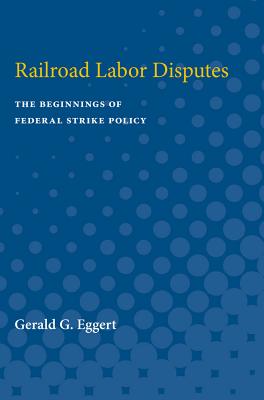At Martinsburg, West Virginia, on July 16, 1877, angry laborers struck the B & O Railroad because of a 10 percent wage cut. Spontaneous strikes soon choked railroad service from Baltimore to St. Louis and from Buffalo to Louisville. The violent wave of discontent developed into the country’s first national labor crisis. The use of federal troops to restore order was only one of many decisions-sometimes blundering or biased, sometimes enlightened-the government would make during the next twenty years in coping with railway strikes. Not until the defeat of the Pullman Strike in 1894 did railway labor disorders subside. Railroad Labor Disputes describes the federal government’s methods of dealing with railroad labor problems in the last quarter of the nineteenth century and shows how the beginnings of federal strike policy evolved. To explain the bias of government officials against the working man and for railroad management, Gerald Eggert examines the backgrounds, interests, and ambitions of the shapers of federal policy. Eggert also underscores the lack of congressional leadership and the erratic planning of the executive branch, which compelled the federal courts to play a large part in making policy. Particularly in times of crisis, accident and chance determined the policy as much as reason and forethought. Occasionally decisions supported strikers, but policy became increasingly anti-labor in its bias. "Riots" and "insurrections" were quelled by troops; "conspiring to obstruct the mails" justified federal strikebreaking; hampering interstate commerce produced federal reprisal. Court injunctions were first used to protect railroads in receivership, later any railroad at any time. Strikes were even judged violations of the Sherman Antitrust Act. After the Pullman strike of 1894, government policy grew more reasonable. Eggert emphasizes that the Erdman Act reflected this trend. Thereafter, railroad officials increasingly accepted the principle of collective bar
| FindBook |
有 1 項符合
Railroad Labor Disputes: The Beginnings of Federal Strike Policy的圖書 |
 |
Railroad Labor Disputes: The Beginnings of Federal Strike Policy 作者:Eggert 出版社:University of Michigan Press 出版日期:1967-01-01 語言:英文 規格:平裝 / 324頁 / 22.9 x 15.2 x 1.8 cm / 普通級 |
| 圖書館借閱 |
| 國家圖書館 | 全國圖書書目資訊網 | 國立公共資訊圖書館 | 電子書服務平台 | MetaCat 跨館整合查詢 |
| 臺北市立圖書館 | 新北市立圖書館 | 基隆市公共圖書館 | 桃園市立圖書館 | 新竹縣公共圖書館 |
| 苗栗縣立圖書館 | 臺中市立圖書館 | 彰化縣公共圖書館 | 南投縣文化局 | 雲林縣公共圖書館 |
| 嘉義縣圖書館 | 臺南市立圖書館 | 高雄市立圖書館 | 屏東縣公共圖書館 | 宜蘭縣公共圖書館 |
| 花蓮縣文化局 | 臺東縣文化處 |
|
|
圖書介紹 - 資料來源:博客來 評分:
圖書名稱:Railroad Labor Disputes: The Beginnings of Federal Strike Policy
|











